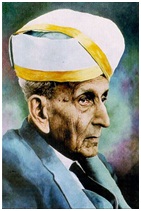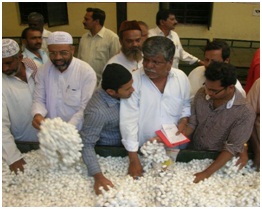Sericulture
Sericulture in Karnataka
Video Credits:www.youtube.com
Sericulture is a tradition in Karnataka and culturally the state accords great value to Silk. It is a fascinating story of Soil to Silk & Fabric.The farm and non-farm activities create employment for 60-70 lakh people every year mostly in rural India. Sericulture offers scope of transferring wealth from high and urban customers to farmers and artisan classes. Rural employment generation and inclusive development is readily addressed by Sericulture and is significant rural transformation Sector. 60% of the work in sericulture is done by women and sericulture plays a key role in rural women empowerment. In several districts of the State, the sericulture is mainstay and livelihood of small, marginal farmers and weaker sections of the society and traditional source of livelihood. sericulture and silk industries are important sectors of employment for nearly 12 lakh households in Karnataka.
History of Sericulture
 The Mysore Silk is synonymous with splendor and grandeur. Mysore silk has been registered as Geographical Indicator under Intellectual Property Rights. Karnataka is the homeland of Mysore Silk. Karnataka sericulture has a history of more than 215 years. In 1785, the Tiger of Mysore Tippu Sultan established sericulture in Mysore kingdom. He wanted Mysore to be the foremost among silk producing nations. The dream of this great ruler became true during later period. During these years Karnataka sericulture has seen many ups and downs in its long journey. It has transformed into a model in mulberry sericulture in the country. During early 19th century while the world sericulture was collapsing, Mysore Sericulture industry sustained. Though, most of the exotic silkworm varieties perished remained stable through this period, and even today it is the back bone of mulberry sericulture in India.
The Mysore Silk is synonymous with splendor and grandeur. Mysore silk has been registered as Geographical Indicator under Intellectual Property Rights. Karnataka is the homeland of Mysore Silk. Karnataka sericulture has a history of more than 215 years. In 1785, the Tiger of Mysore Tippu Sultan established sericulture in Mysore kingdom. He wanted Mysore to be the foremost among silk producing nations. The dream of this great ruler became true during later period. During these years Karnataka sericulture has seen many ups and downs in its long journey. It has transformed into a model in mulberry sericulture in the country. During early 19th century while the world sericulture was collapsing, Mysore Sericulture industry sustained. Though, most of the exotic silkworm varieties perished remained stable through this period, and even today it is the back bone of mulberry sericulture in India.
 In 1800 the Mysore Royal Government established sericulture in Mogenahalli near Channapatna, which became the center of sericulture activities soon. In 1860, first silk filature was established in Bangalore by an Italian industrialist. During this period many exotic Italian or Chinese or Japanese races were used to produce cross breed layings by this filature. In 1896, great industrialist Sir J.N.Tata established a Silk Farm with a filature attached to it in Japanese pattern, in Bangalore, with the help of Sri. K. Sheshadri Ayyar, the Diwan of Mysore. He got the technical expertise from Japanese couple Mr and Mrs Odzu, who gave scientific outlook for the Sericulture industry. Mr. Odzu trained Sri. V.M.Appadhorai Mudaliar and Sri. Laxman Rao for a period of one year in this farm.
In 1800 the Mysore Royal Government established sericulture in Mogenahalli near Channapatna, which became the center of sericulture activities soon. In 1860, first silk filature was established in Bangalore by an Italian industrialist. During this period many exotic Italian or Chinese or Japanese races were used to produce cross breed layings by this filature. In 1896, great industrialist Sir J.N.Tata established a Silk Farm with a filature attached to it in Japanese pattern, in Bangalore, with the help of Sri. K. Sheshadri Ayyar, the Diwan of Mysore. He got the technical expertise from Japanese couple Mr and Mrs Odzu, who gave scientific outlook for the Sericulture industry. Mr. Odzu trained Sri. V.M.Appadhorai Mudaliar and Sri. Laxman Rao for a period of one year in this farm.
 The Architect of Mysore Sir M.Vishveshwaraiah gave much importance to Sericulture in rural development. He hired the services of Signor Washington Mari from Italy to organize and develop silk industry in Mysore in 1913. Signor Mari made available 12 varieties of pure European and Chinese silkworm to conduct experiments. Under the guidance of Signor Mari, Appadhorai Mudaliar conducted native environment breeding experiments in Channapatna. They successfully developed many cross breed combinations between females of Mysore Local (Pure Mysore) and males of European and Chinese races, which were far superior to their parents. In 1914, Signor Mari shifted his headquarters to Bangalore, and Mudaliar continued to carry out the breeding experiments in Channapatna Farm. In 1914 independent Department of Sericulture was established and Signor Washington Mari became the first Director of Sericulture. In 1919, Government hired the services of Japanese expert, Mr. Yonemura for conducting research and imparting training in sericulture. Government started Silk filature in 1922 and Silk weaving factory in 1931-32 at Mysore.
The Architect of Mysore Sir M.Vishveshwaraiah gave much importance to Sericulture in rural development. He hired the services of Signor Washington Mari from Italy to organize and develop silk industry in Mysore in 1913. Signor Mari made available 12 varieties of pure European and Chinese silkworm to conduct experiments. Under the guidance of Signor Mari, Appadhorai Mudaliar conducted native environment breeding experiments in Channapatna. They successfully developed many cross breed combinations between females of Mysore Local (Pure Mysore) and males of European and Chinese races, which were far superior to their parents. In 1914, Signor Mari shifted his headquarters to Bangalore, and Mudaliar continued to carry out the breeding experiments in Channapatna Farm. In 1914 independent Department of Sericulture was established and Signor Washington Mari became the first Director of Sericulture. In 1919, Government hired the services of Japanese expert, Mr. Yonemura for conducting research and imparting training in sericulture. Government started Silk filature in 1922 and Silk weaving factory in 1931-32 at Mysore.
 During later part of 1970s under ISDP and during 1980s under World Bank aided two sericulture projects Department of Sericulture took up extensive expansion programmes. Infrastructures like, grainages, Technical Service Centers cocoon markets, were established. This boosted the raw silk production to 9236 MT during 1997-98. Present status Directly and indirectly sericulture is providing jobs for about 10.67 lakh people. One hectare of Mulberry provides year long continuous job for 13 persons. Karnataka has well established Multivoltine and Bivoltine Seed areas. They cater to the demand of parental seed cocoons required for the production of cross breed and bivoltine hybrid layings. Almost 88% of Karnataka sericulture is spread in southern part of Karnataka, which is fast modernizing. Factors like urbanization, industrialization, depleting water table, scarcity of agriculture labour have affected sericulture in this part.
During later part of 1970s under ISDP and during 1980s under World Bank aided two sericulture projects Department of Sericulture took up extensive expansion programmes. Infrastructures like, grainages, Technical Service Centers cocoon markets, were established. This boosted the raw silk production to 9236 MT during 1997-98. Present status Directly and indirectly sericulture is providing jobs for about 10.67 lakh people. One hectare of Mulberry provides year long continuous job for 13 persons. Karnataka has well established Multivoltine and Bivoltine Seed areas. They cater to the demand of parental seed cocoons required for the production of cross breed and bivoltine hybrid layings. Almost 88% of Karnataka sericulture is spread in southern part of Karnataka, which is fast modernizing. Factors like urbanization, industrialization, depleting water table, scarcity of agriculture labour have affected sericulture in this part.
Reshme Krushi Bi Monthly Magazines in Regional Language On Sericulture
Sep - Oct 2021
May - Aug 2021
Mar - Apr 2021
Jan - Feb 2021
Nov - Dec 2020
Sep - Oct 2020
Jul - Aug 2020
Mar - Jun 2020 (1)
Mar - Jun 2020 (2)
Jan - Feb 2020
Nov - Dec 2019
Sep - Oct 2019
Jul - Aug 2019
May - Jun 2019
Mar - Apr 2019
Jan - Feb 2019
Source: Sericulture Department of Karnataka https://sericulture.karnataka.gov.in/info-1/Importance+of+Sericulture/en